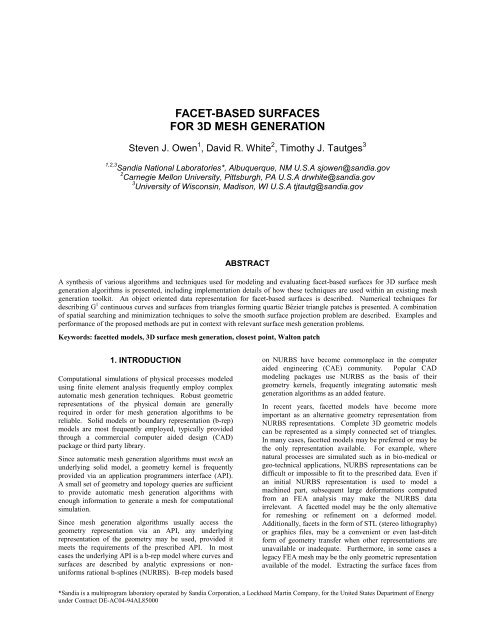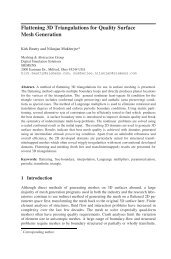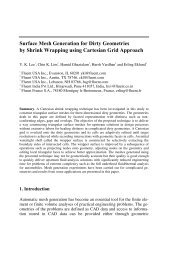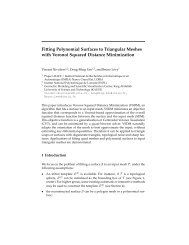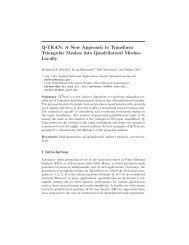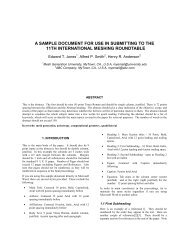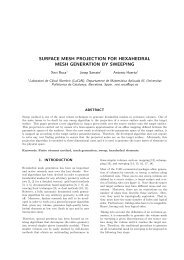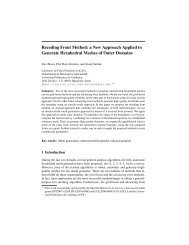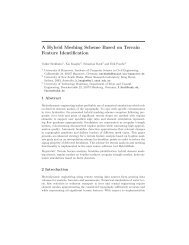facet-based surfaces for 3d mesh generation - CiteSeerX
facet-based surfaces for 3d mesh generation - CiteSeerX
facet-based surfaces for 3d mesh generation - CiteSeerX
Create successful ePaper yourself
Turn your PDF publications into a flip-book with our unique Google optimized e-Paper software.
FACET-BASED SURFACESFOR 3D MESH GENERATIONSteven J. Owen 1 , David R. White 2 , Timothy J. Tautges 31,2,3 Sandia National Laboratories*, Albuquerque, NM U.S.A sjowen@sandia.gov2 Carnegie Mellon University, Pittsburgh, PA U.S.A drwhite@sandia.gov3 University of Wisconsin, Madison, WI U.S.A tjtautg@sandia.govABSTRACTA synthesis of various algorithms and techniques used <strong>for</strong> modeling and evaluating <strong>facet</strong>-<strong>based</strong> <strong>surfaces</strong> <strong>for</strong> 3D surface <strong>mesh</strong><strong>generation</strong> algorithms is presented, including implementation details of how these techniques are used within an existing <strong>mesh</strong><strong>generation</strong> toolkit. An object oriented data representation <strong>for</strong> <strong>facet</strong>-<strong>based</strong> <strong>surfaces</strong> is described. Numerical techniques <strong>for</strong>describing G 1 continuous curves and <strong>surfaces</strong> from triangles <strong>for</strong>ming quartic Bézier triangle patches is presented. A combinationof spatial searching and minimization techniques to solve the smooth surface projection problem are described. Examples andper<strong>for</strong>mance of the proposed methods are put in context with relevant surface <strong>mesh</strong> <strong>generation</strong> problems.Keywords: <strong>facet</strong>ted models, 3D surface <strong>mesh</strong> <strong>generation</strong>, closest point, Walton patch1. INTRODUCTIONComputational simulations of physical processes modeledusing finite element analysis frequently employ complexautomatic <strong>mesh</strong> <strong>generation</strong> techniques. Robust geometricrepresentations of the physical domain are generallyrequired in order <strong>for</strong> <strong>mesh</strong> <strong>generation</strong> algorithms to bereliable. Solid models or boundary representation (b-rep)models are most frequently employed, typically providedthrough a commercial computer aided design (CAD)package or third party library.Since automatic <strong>mesh</strong> <strong>generation</strong> algorithms must <strong>mesh</strong> anunderlying solid model, a geometry kernel is frequentlyprovided via an application programmers interface (API).A small set of geometry and topology queries are sufficientto provide automatic <strong>mesh</strong> <strong>generation</strong> algorithms withenough in<strong>for</strong>mation to generate a <strong>mesh</strong> <strong>for</strong> computationalsimulation.Since <strong>mesh</strong> <strong>generation</strong> algorithms usually access thegeometry representation via an API, any underlyingrepresentation of the geometry may be used, provided itmeets the requirements of the prescribed API. In mostcases the underlying API is a b-rep model where curves and<strong>surfaces</strong> are described by analytic expressions or nonuni<strong>for</strong>msrational b-splines (NURBS). B-rep models <strong>based</strong>on NURBS have become commonplace in the computeraided engineering (CAE) community. Popular CADmodeling packages use NURBS as the basis of theirgeometry kernels, frequently integrating automatic <strong>mesh</strong><strong>generation</strong> algorithms as an added feature.In recent years, <strong>facet</strong>ted models have become moreimportant as an alternative geometry representation fromNURBS representations. Complete 3D geometric modelscan be represented as a simply connected set of triangles.In many cases, <strong>facet</strong>ted models may be preferred or may bethe only representation available. For example, wherenatural processes are simulated such as in bio-medical orgeo-technical applications, NURBS representations can bedifficult or impossible to fit to the prescribed data. Even ifan initial NURBS representation is used to model amachined part, subsequent large de<strong>for</strong>mations computedfrom an FEA analysis may make the NURBS datairrelevant. A <strong>facet</strong>ted model may be the only alternative<strong>for</strong> re<strong>mesh</strong>ing or refinement on a de<strong>for</strong>med model.Additionally, <strong>facet</strong>s in the <strong>for</strong>m of STL (stereo lithography)or graphics files, may be a convenient or even last-ditch<strong>for</strong>m of geometry transfer when other representations areunavailable or inadequate. Furthermore, in some cases alegacy FEA <strong>mesh</strong> may be the only geometric representationavailable of the model. Extracting the surface faces from*Sandia is a multiprogram laboratory operated by Sandia Corporation, a Lockheed Martin Company, <strong>for</strong> the United States Department of Energyunder Contract DE-AC04-94AL85000
the elements to <strong>for</strong>m <strong>facet</strong>s is one alternative to provide ageometric model <strong>for</strong> subsequent design studies.In the ideal case, <strong>mesh</strong> <strong>generation</strong> software has beendesigned to work through a generic API, not relying on anyspecific geometry representation. When this is the case, a<strong>facet</strong>ted representation may conveniently replace or serveas an alternative geometry kernel with little or no change tothe <strong>mesh</strong> <strong>generation</strong> algorithms themselves. The objectiveof the current work is to propose such a system. Significantprior work has gone into developing a <strong>mesh</strong> <strong>generation</strong>toolkit [1], consisting of a wide variety of algorithms[2,3,4,5,6] that will access a generic geometry kernelthrough a common geometry module [7]. Although thecommercial third party library, ACIS [8], has beensuccessfully used as a NURBS-<strong>based</strong> geometry kernel, analternative <strong>facet</strong>-<strong>based</strong> geometry representation isproposed. It does not necessarily replace the ACISrepresentation, but serves to enhance the existing capabilityof the <strong>mesh</strong> <strong>generation</strong> toolkit.This work is a synthesis of a variety of algorithms andtechniques used to successfully model <strong>surfaces</strong> <strong>for</strong>purposes of <strong>mesh</strong> <strong>generation</strong>. This work does not presentor promote any specific <strong>mesh</strong>ing algorithm, but insteadproposes a geometry system that can be utilized by ageneric 3D <strong>mesh</strong>ing algorithm.We first present some background to the problem in orderto put the subsequent discussion into perspective. We willthen describe the data representation used followed by adetailed description of the numerical <strong>for</strong>mulation of the<strong>surfaces</strong>. Details of how the <strong>facet</strong>ted surface representationis used within the context of 3D surface <strong>mesh</strong>ing will thenbe described along with relevant per<strong>for</strong>mance data.Finally, several examples will be presented, showingtypical use of the <strong>facet</strong>ted representation <strong>for</strong> 3D <strong>mesh</strong><strong>generation</strong>.2. BACKGROUND2.1 Previous WorkSeveral authors have presented similar <strong>facet</strong>-<strong>based</strong> systems<strong>for</strong> use with specific <strong>mesh</strong> <strong>generation</strong> algorithms. Forexample, Rypl and Bittnar [9] propose a method <strong>for</strong>evaluating <strong>facet</strong>-<strong>based</strong> <strong>surfaces</strong> <strong>based</strong> upon interpolationsubdivision. This method utilizes the hierarchal recursiverefinement of the <strong>facet</strong>s. Control points <strong>for</strong> a triangularBézier patch are positioned by computing a weightedaverage of neighboring nodes resulting in a C 1 surface.Their <strong>facet</strong>-<strong>based</strong> surface representation is employed with a3D advancing front triangle <strong>mesh</strong>ing algorithm. Frey andGeorge [10] also provide details on the use of triangleBézier patches <strong>for</strong> modeling <strong>surfaces</strong> of prescribedcontinuity <strong>for</strong> application to finite element <strong>mesh</strong><strong>generation</strong>. Additionally, Frey [11], and Laug andBorouchaki [12] address issues related to parametric space<strong>mesh</strong> <strong>generation</strong> on <strong>facet</strong>-<strong>based</strong> <strong>surfaces</strong>. The currentef<strong>for</strong>t, in contrast addresses integration of a <strong>facet</strong>-<strong>based</strong>system as a geometry kernel <strong>for</strong> 3D surface <strong>mesh</strong><strong>generation</strong>.The current work extends the previous work of the authors[13] where a method <strong>for</strong> decomposing a finite elementmodel to generate a complete geometric model <strong>for</strong> <strong>mesh</strong><strong>generation</strong> was proposed. Sets of <strong>facet</strong>s were generatedand grouped together to <strong>for</strong>m <strong>surfaces</strong> <strong>based</strong> upon userdefined feature angle criteria and boundary condition data.The current work assumes that <strong>facet</strong>s have been adequatelygrouped into topological <strong>surfaces</strong> as described in [13].2.2 Surface MeshingSurface <strong>mesh</strong>ing algorithms may be characterized as eitherparametric or 3D. A parametric surface-<strong>mesh</strong>ing algorithmcreates the <strong>mesh</strong> in a two-dimensional space, mapping thefinal nodal coordinates to three dimensions only as a finalstep. Many examples of parametric surface <strong>mesh</strong>ing existin the literature [14,15,16]. Fundamental to parametric<strong>mesh</strong>ing is a global 2D parametric (u,v) representation <strong>for</strong>the entire surface. NURBS representations provided byCAD modelers conveniently provide this in<strong>for</strong>mation. For<strong>facet</strong>ted models, however, surface parameterizations are noteasy to come by and are a topic of active research [17,18].3D <strong>mesh</strong>ing algorithms, on the other hand, do not requirean underlying parameterization. Rather than mappingbetween 2D and 3D spaces, the <strong>mesh</strong>ing algorithm isper<strong>for</strong>med completely within the 3D space. The currentwork restricts its application to 3D <strong>mesh</strong>ing algorithms,leaving parametric <strong>mesh</strong>ing to subsequent research.Paving [2] and 3D advancing front triangle <strong>mesh</strong>ing [19]are examples of 3D <strong>mesh</strong>ing algorithms. These algorithmsbegin with an outer loop of <strong>mesh</strong> edges and begin placingelements on the surface marching systematically from theboundary towards the interior. Fundamental to thesealgorithms is the evaluation of the underlying surface. Theclosest point or projection routine combined with surfacenormal evaluations at a point are the main requirementsthese algorithms demand of the geometry kernel. While inmost cases these functions are standard API calls availablefrom a NURBS-<strong>based</strong> geometry system, they must bedefined <strong>for</strong> a <strong>facet</strong>-<strong>based</strong> system. This work proposesseveral techniques <strong>for</strong> defining these routines <strong>for</strong> <strong>facet</strong><strong>based</strong>representations.2.4 G 0 SurfacesThe <strong>facet</strong> representation can be characterized by thegeometric continuity <strong>for</strong> which the composite set oftriangles comprising a surface will maintain.For purposes of this work, we will not consider parametriccontinuity (ie. C 0 ,C 1 , …), as 3D surface <strong>mesh</strong>ing schemeswill be employed. Instead G 0 and G 1 continuousrepresentations will be considered. Farin [20] details therequirements of continuity across surface patchescomposed of Bézier patches. Kashyap [21] addresseshigher order continuity between triangle patches.A surface maintaining G 0 continuity guarantees only thatthat the <strong>facet</strong> edges meet edge-to-edge, without gaps. Inthis case, characteristic <strong>facet</strong>s and ridges between trianglesmay be evident. In many cases, G 0 is sufficient toadequately characterize the surface <strong>for</strong> <strong>mesh</strong> <strong>generation</strong>.Planar <strong>surfaces</strong>, <strong>surfaces</strong> with large curvature or <strong>surfaces</strong>
with sufficiently dense triangles to represent curvature, maynot require more than what a G 0 <strong>facet</strong> representation willprovide. Since higher order representations will inevitablybe more expensive, the option to provide <strong>for</strong> G 0representations should be supplied in a <strong>facet</strong>-<strong>based</strong>geometry kernel <strong>for</strong> <strong>mesh</strong> <strong>generation</strong>.Triangles may be conveniently parameterized usingBarycentric coordinates. Instead of the standard u,vparameterization of tensor product <strong>surfaces</strong>, threeparameters, u,v,w, are used, where u+v+w=1 and u,v,w ≥0.Figure 1 shows the characteristic parametric domain <strong>for</strong>any triangle.triangle patch. For example, Figure 2 shows the polarcoordinate locations <strong>for</strong> triangle patches n=3 and n=4.Figure 2. Polar values <strong>for</strong> triangles patches of n=3and n=4It has been established that the minimum order of a triangleBézier patch necessary to model a G 1 surface is n=4 [22].For this case, equation (3) can be written as:Figure 1. Barycentric coordinate system definedon a triangle.Using Barycentric coordinates (u,v,w) any point X in thedomain may be defined as:X( uvw , , ) = uP + vP + wP (1)0 1 2where P 0 , P 1 , P 2 are the vertices of the triangle. In a similarmanner, the normal at point X can be approximated as:NX ( uvw , , ) = uN0 + vN1+wN 2(2)where N 0 , N 1 , N 2 are the approximated normals at pointsP 0 , P 1 , P 2 respectively.2.2 G 1 SurfacesIt may be necessary to provide a smooth approximation tothe surface. To do so, Bézier triangular patches may bedefined. A degree n triangular Bézier patch may bedescribed with the following equation:X( uvw , , ) = ∑ B ni, j, k( uvw , , ) Pi, j,k(3)Bi+ j+ k=nn!= u v w(4)i! j! k!n i j ki, j,kP i,j,k are the control points of the triangle and B i,j,k (u,v,w)can be thought of as the weights at polar location i,j,k,where i+j+k =n. Note also that equation (1) can bethought of as a special case of equation (3) where n=1. Inthis case B ijk =1 <strong>for</strong> all i,j,k.Triangular polar values are a convenient way ofgeneralizing the control point indices <strong>for</strong> an arbitrary( , , )4X uvw = P0,0,4w+3 34P1,0,3uw+ 4P0,1,3vw+2 2 3 2 26P2,0,2uw + 12P1,1,2 uvw + 6P0,2,2vw+3 2 2 3P3,0,1u w+ P2,1,1u vw+ P1,2,1uv w+ P0,3,1v w+4 3 2 2 3 44,0,0u + 43,1,0uv+ 62,2,0uv + 41,3,0uv+0,4,0v4 12 12 4P P P P PWalton [23] describes a procedure <strong>for</strong> defining P i,j,k as afunction of the triangle vertex locations P i {i=0..3} andnormals N i {i=0..3}. The Walton patch is central to thetechniques proposed in the present work. How it is usedwithin the context of a practical geometry kernel <strong>for</strong> <strong>mesh</strong><strong>generation</strong> is the additional contribution proposed by thecurrent research and development ef<strong>for</strong>t. Definition andimplementation of the Walton patch is outlined in section 5.Similarly, smooth normals <strong>for</strong> the quartic patch at X(u,v,w)may be computed by evaluating a cubic Bézier patch.3N ( uvw x, , ) = N w 0,0,3+2 23N1,0,2uw+ 3N0,1,2vw+2 23N2,0,1uw+ 6N1,1,1uvw+ 3N0,2,1vw+3 2 2 33,0,0u + 32,1,0u v+ 31,2,0uv +0,3,0vN N N NAssuming the normals at N 3,0,0 , N 0,3,0 ,andN 0,0,3 are thecomputed normals at the triangle vertices N 0 , N 1 and N 2respectively, a procedure <strong>for</strong> computing the remaining N i,j,kby extending the work of Walton is introduced in section 5.3. DATA REPRESENTATIONAs stated in the Introduction, <strong>facet</strong>-<strong>based</strong> surfaceconstruction is employed in a variety of contexts. Thesetypes of <strong>surfaces</strong> can be used to support <strong>mesh</strong> <strong>generation</strong> on<strong>facet</strong>-<strong>based</strong> models. The method used to store and evaluatethe <strong>facet</strong> data can vary according to the source of thosedata. For example, in the context of large-de<strong>for</strong>mationFEA, it is important to maintain links between the original<strong>mesh</strong> and the corresponding <strong>facet</strong>s used to model thesurface. Also, <strong>for</strong> these analyses, duplication and updatingof <strong>facet</strong> data can be problematic because of memorylimitations commonly found in parallel computing(5)(6)
environments and because position and topology of <strong>facet</strong>smay be changing. Facets originating from STL or graphicsfiles may not have those limitations. In contrast, thefunctions needed to support <strong>mesh</strong> <strong>generation</strong> do not dependon the source of the <strong>facet</strong>s being evaluated, and there<strong>for</strong>eshould look the same regardless of the <strong>facet</strong> representation.We accomplish both these goals utilizing inherited classesin C++ <strong>for</strong> our <strong>facet</strong> data structure.We define a generic FacetEntity class, from which genericPoint, FacetEdge and Facet classes are derived. Containedin these classes is the normal and control point datanecessary to describe the G 1 surface approximation. Asimplified representation of the data contained in theseclasses is illustrated in Figure 3.class FacetEntity {}class Facet : public FacetEntity {Vector3D *controlPoints;Vector3D normal;Box boundingBox;virtual get_points() = 0;}class FacetEdge : public FacetEntity {Vector3D *controlPoints;Boolean isFeature;virtual get_adjacent_<strong>facet</strong>s() = 0;}class Point : public FacetEntity {List normalList;virtual get_location() = 0;virtual get_adjacent_<strong>facet</strong>s() = 0;}class PointNormal (Vector3D normal;int surfaceID;}Figure 3. Simplified C++ classes used <strong>for</strong> defining<strong>facet</strong> representationThese classes also support typical functionality like pointlocation and point-edge-<strong>facet</strong> adjacency. These functionsare defined as virtual functions to allow representationspecificversions to be implemented. An exampleinheritance tree <strong>for</strong> the <strong>facet</strong> representation is illustrated inFigure 4.The actual implementation of the functions described aboveis done in classes derived from Facet, FacetEdge and Point.We describe here two specific implementations: one thatstores the <strong>facet</strong> data in the actual derived classes, and onethat references those data from an analysis application. Inthe first child class, PointData, the point data (i.e.coordinates and adjacency in<strong>for</strong>mation) are stored in theclass and are used directly to implement the requiredfunctions. This is illustrated in Figure 4 in the box markedA. The second implementation example, in the FEAPointclass, does not store the point data in the class; those dataare retrieved from the <strong>mesh</strong> objects in the FEA code, towhich the FEAPoint object keeps a pointer. Box B inFigure 4 illustrates this case. Implementations of theFacetEdge and Facet classes are similar to those <strong>for</strong> Point.Figure 4. Inheritance tree <strong>for</strong> object oriented <strong>facet</strong>representationThe proposed object oriented implementation also leavesopen the possibility <strong>for</strong> additional code reuse. Otherapplications need only supply the required topologyin<strong>for</strong>mation <strong>for</strong> the <strong>facet</strong>s in order to take advantage of theproposed surface representation and evaluation.4. FACET INITIALIZATION AND EVALUATIONThe following procedure outlines the proposed process <strong>for</strong>initializing <strong>facet</strong>-<strong>based</strong> <strong>surfaces</strong> <strong>for</strong> use as a geometrykernel <strong>for</strong> 3D <strong>mesh</strong> <strong>generation</strong>. Figure 3 illustrates thebasic data needed to sufficiently describe the smoothsurface. Control point and normal data necessary tocompute equations (5) and (6) are necessary. Dependingon the speed vs memory requirements of the application,this data may be precomputed and stored with the <strong>facet</strong>entities or may be computed only as evaluations arerequired. For the <strong>mesh</strong> <strong>generation</strong> applications used withthis work, it was found that pre-computing the normal andcontrol point data was more efficient.It should be noted that curves and <strong>surfaces</strong> with zerocurvature can be accurately modeled with a G 0 surfacerepresentation. Given that many <strong>surfaces</strong> used to modelmachined parts have flat <strong>surfaces</strong>, it is worthwhile to check<strong>for</strong> this condition and only initialize those with anycurvature. Furthermore, it may be worthwhile to per<strong>for</strong>m aninitial decimation of the <strong>facet</strong>s comprising the surface toreduce memory requirements and increase the per<strong>for</strong>manceof the closest_point operation discussed later.The initialization procedure begins first with theapproximation of the normals at the Points. The normalsare then used as input to compute the control points on theFacetEdges. Finally, the control point data on the Facets iscomputed using the FacetEdge control points. Details <strong>for</strong>initializing each of these data objects is now described.4.1 PointsThe definition of Bézier triangle <strong>facet</strong>s requires normals tobe provided or approximated at each of the <strong>facet</strong> vertices.If normals are available from an external source, such asthose provided through an STL <strong>for</strong>mat, these should ideally
e used. If they are not provided, it is necessary toapproximate them. Reference [13] describes the methodused in the current work, defining the normal, N P at a pointas the weighted average of the adjacent <strong>facet</strong>s, N j ,wherethe weight, w j is the normalized <strong>facet</strong> angle at the point.Equations (7), (8) and Figure 5 describe this procedure.nN = ∑N w(7)P j jj = 1αiw i = n∑αii=1(8)Figure 6. FacetEdge required input to computecontrol points P i,jN 6N 5PN Pα 1α 2α 3N 4N 1N 2N 3Figure 5. Definition of a normal at point PAt feature breaks, it is necessary to compute multiplenormals at a point, where the normal is the weightedaverage of only the <strong>facet</strong> normals defined on a givensurface. Figure 3 describes the Point class as containing alist of PointNormal objects. The PointNormal objectcontains both the computed normal and a reference to thesurface to which it applies. It should be emphasized thatthis extra in<strong>for</strong>mation is only required at breaks or surfaceboundaries to distinguish surface features and is onlyallocated at the Points as needed to ensure minimaladditional memory overhead.4.2 Facet EdgesTo completely represent the quartic Bézier <strong>facet</strong> edge, fivecontrol points are needed. In addition to serving as thecontrol points <strong>for</strong> the boundary curves, The control pointson the FacetEdges are utilized in the definition of thetriangle Bézier patches (discussed later) that areimmediately adjacent the FacetEdge. Adjacencyin<strong>for</strong>mation provided by the data representation describedin the previous section is necessary to keep track of thisdata and utilize it as necessary.Since we may utilize the Point locations <strong>for</strong> the ends of theBézier curve, the remaining three control points, P i, j{j=1..3} may be stored with the FacetEdge. In practice, therequired input to compute P i,j (Figure 6) are the FacetEdgeendpoints P i , P i+1 , the surface normals, N i , N i+1 and thecurve tangent vectors, T i , T i+1 at the same points.It is assumed that point P i and P i+1 are provided. Theprevious section addresses approximation of normals N i ,N i+1 . In order to maintain G 0 continuity between adjacent<strong>facet</strong>-<strong>based</strong> <strong>surfaces</strong>, it is necessary to approximate thecurve tangents, T i , T i+1 . For edges on the interior of thesurface where G 1 continuity is to be maintained, it issufficient to define both T i and T i+1 as the direction of theFacetEdgePTi= Ti+1=Pi+1i+1− Pi− PFor edges marked as Features, using equation (9) mayresult in gaps between the <strong>facet</strong>s as illustrated in Figure 7.In this example a cylinder has been represented with acoarse set of <strong>facet</strong>s. Facet A and Facet B are on different<strong>surfaces</strong>, but are required to meet at edge P i P i+1 . Usingonly the <strong>facet</strong> normals and the tangents of equation (9),gaps between the <strong>facet</strong>s would result in different P i,j <strong>for</strong> thesame edge depending upon which <strong>facet</strong> is used <strong>for</strong> thecomputation. This is illustrated in Figure 7 by (P i,j ) A and(P i,j ) B computed from Facet A and Facet B respectively.Instead, the following logic is employed:⎧L 11 cos( ),i Lii i θ−⎪L⋅ L −
1 1i,2 = i,1 + i,22 2P V V (24)3 1i,3 = i,2 + i+ 14 4P V P (25)In the current work, P i,j from equations (23) to (25) arestored with the FacetEdge. To further ensure continuitybetween <strong>facet</strong>s on adjoining <strong>surfaces</strong>, it is necessary toaverage the final locations P i,j computed with respect toeach adjoining <strong>facet</strong>.Sincetheobjectiveofthisexerciseistoprovideameanstoevaluate equation (5), the following correspondence existsbetween the points P i,j,k defined with polar indices, P i andP i,j .Figure 7. Cylinder represented by coarse <strong>facet</strong>s.Tangent vectors required to maintain G 0continuity between <strong>surfaces</strong>.Figure 7 illustrates the location of point (P i ) prev and(P i+1 ) next . These are the previous and next vertices onadjacent FacetEdges to P i and P i+1 respectively that are on afeature edge. Note that multiple feature edges may meet ata single point P. In this case, the appropriate selection of(P i ) prev and (P i+1 ) next must be determined from localtopology by traversing FacetEdges in order at P i and P i+1 tolocate the next FacetEdge marked as a feature.Armed with the six vectors described in Figure 6, we arenow prepared to compute the three control points P i,j{j=0..3}. The procedure used is defined in Walton andMeeks [23], but is illustrated here <strong>for</strong> clarity. Note themodification to the Walton patch to accommodate thetangent vectors defined in equations (10) and (11) at featureedges.d i = i+1 − iP P (15)N N (16)a i = i ⋅ i+1a = N ⋅T (17)i,0i ia i,1 = i+ 1 ⋅ i+1N T (18)6(2 a + aa )ρ =ii,0 i i,124 − ai6(2 a + aa )σ =ii,1= i +i,1 i i,024 − aii(6Ti − 2 Ni + Ni1)18(19)(20)d ρ σV P +(21)d ρ σV P (22)i,2 = i+1 −i(6Ti+ 1+ Ni + 2 Ni+1)181 3i,1 = i + i,14 4P P V (23)P = P P = P P = P P = PP = P P = P P = P P = PP P P P P P P P4,0,0 0 0,3,1 0,1 1,0,3 1,1 3,1,0 2,10,4,0 1 0,2,2 0,2 2,0,2 1,2 2,2,0 2,20,0,4 = 2 0,1,3 = 0,3 3,0,1 = 1,3 1,3,0 = 2,34.3 Facets(26)Making use of the control points on the FacetEdges, thequartic Bézier patch, control points P 1,1,2 , P 2,1,1 and P 1,2,1 onthe interior of the <strong>facet</strong> can now be defined. The locationsof these points are critical to describing G 1 continuitybetween adjoining patches. Walton and Meeks propose amethod, whereby two candidate locations <strong>for</strong> interiorcontrol points are defined <strong>for</strong> each FacetEdge, resulting insix vectors G i,j {i=0,1,2; j=0,1}. Final locations <strong>for</strong> interiorcontrol points P 1,1,2 , P 2,1,1 and P 1,2,1 are a function of theevaluated (u,v,w) parameters and G i,j . Once again theprocedure outlined by Walton and Meeks is described here<strong>for</strong> clarity.For each FacetEdge, i, in the Facet, compute the following:W = V −P (27)i,0 i,1W = V −V (28)i,1 i,2 i,1W = P −V (29)i,2 i+1 i,21Di,0 = Pi,3 − ( Pi,1+ P i )(30)21Di,1 = Pi,1− ( Pi+1 + P i,3)(31)2i×i,0Ai,0= N WWi,0i+ 1 i,2Ai,2= N × WWi,2Ai,1=Ai,0 + Ai,2Ai,0 + Ai,2(32)(33)(34)
λi,0λi,1D=WD=W⋅ W⋅ Wi,0 i,0i,0 i,0⋅ W⋅ Wi,1 i,2i,2 i,2i,0 i,0 i,0(35)(36)µ = D ⋅A (37)µ = D ⋅A (38)i,1 i,1 i,2The two control points G i,0 , G i,1 with respect to FacetEdge imay now be defined as:1Gi,0 = ( Pi,1 + Pi,2)22 1+ λi,0 Wi,1 + λi,1 Wi,03 32 1+ µ i,0 Ai,1 + µ i,1 Ai,03 31Gi,1 = ( Pi,2 + Pi,3)21 2+ λi,0 Wi,2 + λi,1 Wi,13 31 2+ µ i,0 Ai,2 + µ i,1 Ai,13 3(39)(40)In practice, the six control points, G i,j are stored with theFacet object. When the <strong>facet</strong> is to be evaluated, interiorcontrol points P 1,1,2 , P 2,1,1 and P 1,2,1 may be uniquelyevaluated as:only as needed. If they are precomputed, Two additionalcontrol points per FacetEdge, N i,0 and N i,1 would becomputed and stored. In this case we may take advantageof the cross edge derivative in<strong>for</strong>mation computed inequations (30) and (31).Ni,0=Ni,1=Di,0 × Wi,0Di,0 × Wi,0Di,1 × Wi,2Di,1 × Wi,2(44)(45)The correspondence between the control points N i,j,k inequation (6) and the N i,j at the FacetEdges defined inequations (44) and (45) is as follows:N3,0,0 = N0 N0,2,1 = N0,0 N1,0,2 = N1,0 N2,1,0 = N2,0N0,3,0 = N1 N0,1,2 = N0,1 N2,0,1 = N1,1 N1,2,0 = N2,1(46)N = N0,0,3 2Remaining to be computed is the internal control point ofthe cubic Bézier. This may be computed when the <strong>facet</strong> isevaluated using the interior control points from the quarticBézier as follows:N1,1,1=( P1,2,1 − P2,1,1 ) × ( P1,1,2 −P2,1,1)( P1,2,1 − P2,1,1 ) × ( P1,1,2 −P2,1,1)(47)1,1,2 = 1 ( u 2,2 v 0,1 )u+v+P G G (41)1,2,1 = 1( w 0,2 u 1,1)w+u+P G G (42)2,1,1 = 1( v 1,2 w 2,1)v+w+P G G (43)Finally, in order to evaluate the Bézier <strong>facet</strong> at parameter(u,v,w), equation (5) may be employed by using the controlpoints defined in equation (26) and equations (41) to (43).Care must be taken to extract the appropriate control pointsin the correct order from the FacetEdges and Points so thatcontrol points P i,j,k are appropriately assigned.4.4 NormalsSurface normals may be computed by evaluating the cubicBézier of equation (6). Once again the normals computedat the <strong>facet</strong> vertices N 0 , N 1 , N 2 can be used <strong>for</strong> the controlpoints N 3,0,0 , N 0,3,0 and N 0,0,3 respectively. Left to becomputed are the seven remaining control points: two peredge and one at the center of the triangle.As with the calculation of the quartic control points,depending upon the speed vs. memory requirements of theapplication, the normals <strong>for</strong> the cubic patch of equation (6)may be precomputed and stored, or they may be computedFigure 8. Quartic control point grid showingrelationship to cubic grid of normals.In practice, rather than storing N i,j <strong>for</strong> each FacetEdge, N i,jmay be computed only as needed. Instead of regeneratingthe cross derivatives D i,j <strong>for</strong> equations (44) and (45), thenormals N i,j can be derived directly from the control pointsof the quartic Bézier in a similar manner to equation (47).Figure 8 shows the relationship between the quartic controlpoint grid and the normals required <strong>for</strong> the cubic Bézierpatch. The normal of a local triangle in the quartic Béziercontrol grid should provide a sufficient approximation tothe cubic Bézier control points. There<strong>for</strong>e, the controlpoints <strong>for</strong> the cubic Bézier can be determined as follows:
Ni, j,k=( Pi, j+ 1, k− Pi+ 1, j, k) × ( Pi, j+ 1, k−Pi+1, j,k)( i, j+ 1, k− i+ 1, j, k) × ( i, j+ 1, k−i+1, j,k)P P P P (48){ i+ j+ k = 3, } { i, j, k ≥0}4.5 FacetEdge Evaluation3D <strong>mesh</strong> <strong>generation</strong> algorithms frequently require thecurves to be evaluated. Since we have defined our curvesto be a set of FacetEdges, curve evaluation can utilize thecontrol point in<strong>for</strong>mation stored with the FacetEdge. Oneapproach is to utilize equation (5), setting one of theparameters (u,v,w) to zero. This method however requirescomputing unnecessary control point in<strong>for</strong>mation on the<strong>facet</strong>. Instead, the standard Bézier equation may be used:nnP() t = ∑ Bi() t Pi(49)i=0n n!n−iBi() t = 1−t ti! n i !( ) ( ) −i(50)For the quartic case, evaluation of the FacetEdge, i, Béziercurve at parameter t { 0≤t≤1}using the <strong>facet</strong> vertices P 0 ,P 1 and edge control points P i,j (equations (23) to (25)) maybe defined as:X( t) = P(1 − t) + 4 P (1 − t)t +6 P (1 ) 4 P (1 ) P4 3ii,12 2 3 4i,2 − t t +i,3 − t t +i+1t(51)The tangent vector along the edge may also be computedby evaluating a cubic Bézier.T( t) = T(1 − t) + 3 T (1 − t) t + 3 T (1 − t)t + T t (52)3 2 2 3i i,1 i,2 i+1where T i and T i+1 are defined by equations (9) to (11) ormore generally T i,j may be defined as:{ }Ti, j= Pi, j+1− Pi, jj = 0...3(53)5. CLOSEST POINTThe most common API request <strong>for</strong> 3D <strong>mesh</strong> <strong>generation</strong>algorithms is the closest point, or surface projection: givenan arbitrary point in space, X, find the closest point on thesurface X s . Since this procedure may be called thousandsof times to <strong>mesh</strong> a single surface, an efficient method issought to per<strong>for</strong>m this operation.The closest point calculation involves two main steps. Thefirst task is selection of a small list of <strong>facet</strong>s close to Xfrom which to evaluate. Once this is determined aminimization procedure is employed <strong>for</strong> finding the closestpoint on the <strong>facet</strong> and the distance from X to each <strong>facet</strong> inthe list is computed. The <strong>facet</strong> whose computed distance issmallest is selected as X s .5.1 Closest FacetAn obvious solution to the closest <strong>facet</strong> problem is toproject point X to each of the <strong>facet</strong>s in the surface andselect the point that is the least distance from X. Since thiswould be very inefficient, the objective of the closest <strong>facet</strong>procedure is to minimize the number of <strong>facet</strong>s that musteventually be evaluated. Various spatial searchingtechniques are available in the literature [24]. Theproposed method involves a combination of two methods.5.1.1 Bounding Box Elimination MethodThe first method is a simple bounding box eliminationmethod. In this case, the axis-aligned bounding box ofeach <strong>facet</strong>, B f is evaluated and stored with the Facet object(see Figure 3). This may be done once <strong>for</strong> each <strong>facet</strong> uponinitialization of the <strong>facet</strong> surface. Care should be taken toutilize the Bézier control points in the bounding boxcalculation. Upon projection of point X, a trial axis-alignedbounding box, B X is defined around X such that (B X ) min =X-δ and (B X ) max = X+δ. δ is a small scalar distancerepresentative of the model size. In practice, the diagonalof the model bounding box scaled by 10 -3 is used as theinitial value of δ.Facets selected to evaluate are only those where thebounding box B f overlaps with B X . For this method, every<strong>facet</strong> on the surface must be checked and their boundingboxes verified <strong>for</strong> overlap. If after checking every <strong>facet</strong>, nobounding box B f is found to overlap with B X , δ is scaled by2, B X is recomputed and the <strong>facet</strong>s checked again. Thisprocedure continues, scaling δ each time, until at least oneB f is found to overlap with B X . For 3D <strong>mesh</strong> <strong>generation</strong>algorithms, the point to be projected is generally close tothe surface. As a result, in most cases, not more than asingle pass through the <strong>facet</strong>s is required. Care should betaken in choosing an initial δ, as choosing δ too small couldresult in multiple iterations through the <strong>facet</strong> list be<strong>for</strong>eencountering any overlap. Choosing δ toolarge,ontheother hand, may result in too many <strong>facet</strong>s being selected toevaluate. This procedure can become expensive as thenumber of <strong>facet</strong>s increase. For this reason an alternatespatial search algorithm is utilized.5.1.2 R-Tree Spatial SearchThe dynamic index structure, R-Tree [25],isusedtofindonly the closest <strong>facet</strong>s to evaluate. The R-Tree structurewas selected because of the multi-dimensional searchstructure of the algorithm. Most spatial search algorithmssuch as octrees and kd-trees [26], are typically only useful<strong>for</strong> storing and retrieving k dimensional data. For instance,problems, which involve finding the closest 3D point, canbe readily solved by octrees. Facet data, however, iftrans<strong>for</strong>med into a single point would require ninedimensional octrees (3 dimensions <strong>for</strong> each x-y-z locationof each point). Additionally, determining intersections innine dimensional spaces are often error prone. The R-Treedefined by Guttman is specifically designed to handlemutli-dimensional search spaces efficiently. It is a heightbalancedtree with its leaf nodes containing pointers toFacet objects. The structure is designed so that only asmall number of leaf nodes are visited <strong>for</strong> any searchoperation, however the worst case of the algorithm is notguaranteed to be faster than the traditional n 2 algorithm.The balancing algorithm of the tree is such that this
extreme case will be rare, and in practice the tree appears torun at about O(n) where n is the number of <strong>facet</strong>s.Although relatively efficient, in practice, the overhead ofgenerating and utilizing the additional infrastructure of theR-Tree is not worthwhile <strong>for</strong> small numbers of <strong>facet</strong>s.Timed tests indicated that using only the bounding boxelimination method was more efficient <strong>for</strong> up toapproximately 2000 <strong>facet</strong>s. Where additional <strong>facet</strong>s wereneeded to represent a surface, R-Tree was able to improveper<strong>for</strong>mance considerably. As a result, <strong>for</strong> the currentwork, R-Tree is used only when the number of <strong>facet</strong>s on asurface exceeds 2000.5.2 Closest Point on a FacetLocating the closest point on a <strong>facet</strong>, F i can be per<strong>for</strong>medon the (hopefully) small list of <strong>facet</strong>s determined fromeither the bounding box elimination method or R-Treesearch. For G 0 <strong>surfaces</strong>, this is relatively straight<strong>for</strong>ward,as illustrated by the following procedure5.2.1 Projection to a Linear Facet1. Determine the closest point, X p to the planedefined by F i .d = N ⋅X−N ⋅P (54)pFFF0X = X−dN (55)where N F is the <strong>facet</strong> normal and P 0 is a vertex onF i .2. Determine if X p is inside F i by computing itsbarycentric coordinates with respect to F i .u =v =w =( P2 − P1) × ( Xp−P1)( P − P ) × ( P −P)1 0 2 0( P0 − P2) × ( Xp−P2)( P − P ) × ( P −P)1 0 2 0( P1− P0) × ( Xp−P0)( P − P ) × ( P −P)1 0 2 03. If all parameters u,v,w >0,thenX s = X p(56)(57)(58)4. Otherwise X p is outside F i . Find the closest pointto one of the <strong>facet</strong> edges or <strong>facet</strong> vertices.Let P i {i=0,1,2} be the vertex locations on F i ,then project X p to the closest edge <strong>based</strong> on thefollowing:⎧u< 0, 1⎪i = ⎨v
Given this in<strong>for</strong>mation, the procedure progresses asfollows:1. First check if X is within tolerance, tol of one ofthe <strong>facet</strong> vertices. Define a convergence tolerancerelative to the size of <strong>facet</strong> F i . For example−3tol ≈ area(F ) × 10IF (iX− P < tol) THEN X = P , RETURN.i s i2. Check if A guess is outside the parametric domainof the patch and move it to the parametricboundary.Let A = A guessFOR i=1,2,3; j=(i+1)%3; k=(i+2)%3⎧ A[] i = 0⎪ A[ j]IF ( A[ i]< 0)THEN ⎨A[ j]=(66)⎪ A[ j] + A[ k]⎪⎩A[ k] = 1 −A[ j]3. Let X A =Φ ( A)be the evaluation of the Bézierpatch at parametric location, A (see equation (5))X A =Φ( A )(67)Vmove = X− XA,dmove = V move (68)4. Keep track of the best area coordinate, (A best )thelocation at A best ,(X best ) and its distance from X,(d best ). Initialize with the values computed in (67)and (68). Also keep track of the number ofiterations niter.Abest = A, Xbest = X A,dbest = dmove(69)niter = 0(70)5. Begin Iteration Loop. Check <strong>for</strong> convergenceand ensure the maximum number of iterations,IMAX has not been exceeded.IF (d move < tol OR niter >IMAX)THENX = X , A = As best S bestRETURN6. Parameters u,v,w are not linearly independent(u+v+w=1). Choose a system, of two variables tooptimize.FOR i=0,1,2; j=(i+1)%3; k=(i+2)%3IF (A[i]>A[j] ANDA[i]>A[k]) THENη = j, ξ = k,ψ = i(71)7. Define area coordinates, AηandAξperturbed asmall distance δ from A. in directionsη andξ respectively.Aη[ η] = A[ η]+ δ⎛ A[ ξ ] ⎞Aη[ ξ] = (1 −Aη[ η]) ⎜1−⎟⎝ A[ ξ] + A[ ψ]⎠Aη[ ψ] = 1 −Aη[ η] −Aη[ ξ]Aξ[ ξ] = A[ ξ]+ δ⎛ A[ η]⎞Aξ[ η] = (1 −Aξ[ ξ]) ⎜1−⎟⎝ A[ η] + A[ ψ]⎠Aξ[ ψ] = 1 −Aξ[ η] −Aξ[ ξ]8. Evaluate at Aηandderivative vectorsη and ξ .Aξand approximateVηandVξin directions(72)(73)Φ( Aη) −XAV η =(74)δΦ( Aξ) −XAV ξ =(75)δ9. Compute a search direction tangent to the BezierpatchNηξ = Vη × V ξ(76)Vmove= ( Nηξ× Vmove)× N ηξ (77)10. Project to 2D coordinate plane <strong>based</strong> onmagnitude of NηξFOR i=1,2,3; j=(i+1)%3; k=(i+2)%3IF ( Nηξ[ i] > Nηξ[ j]ANDI=j, J=kNηξ[ i] > N ηξ[ k])THENSolve 2× 2 linear equation in I, J system to determine themove distance dη , dξ in the parameter space.Vmove[I] Vξ[I] Vη[I] Vmove[I]Vmove[J] Vξ[J] Vη[J] Vmove[J]dη= , d[I] [I] ξ =Vη Vξ Vη[I] Vξ[I]Vη[I] Vξ[J] Vη[I] Vξ[J]11. Compute the new trial area coordinate A(78)A[ η] = A [ η] + d η(79)A[ ξ] = A [ ξ] + d ξ(80)A[ ψ ] = 1 −A[ η] −A [ ξ ](81)12. Make sure A remains inside the patch. Useequation (66)13. Evaluate X A at A and set up <strong>for</strong> next iteration.Keep track of the best evaluated location so far.
X = X (82)lastAX =Φ( A )(83)AV = X − X , d = V (84)move A last move moved = X−X (85)XAIF (d X
are computed (Figure 13(a)). Note that multiple normalsmaybecomputedatasinglevertex..(a)(b)Figure 13. (a) Coarse <strong>facet</strong>ing of a cylinder. (b)Computed normals at <strong>facet</strong> vertices.Once normals are computed, the control points arecomputed on each FacetEdge and Facet. Figure 14 (a)shows the control point grids <strong>for</strong> each of the <strong>facet</strong>s. Thenormal in<strong>for</strong>mation can also be computed at this time asshow in Figure 14 (b). Otherwise, the normals may becomputed only as needed.algorithm. Each of these <strong>mesh</strong> <strong>generation</strong> algorithmsutilize the <strong>facet</strong>ted surface described in this work.It should be noted that the resulting node locations on thecylindrical surface described by the <strong>facet</strong>ted surfacerepresentation are within tolerance of reproducing theshape of an exact cylinder.The next example (Figure 16) is a contrived modelintended to illustrate the use of the <strong>facet</strong>-<strong>based</strong> surfacerepresentation within an H-adaptive environment. In thiscase, <strong>facet</strong>s representing two concentric spheres aredefined. The initial <strong>mesh</strong> is defined by only quadrilateralelements, which have been split to <strong>for</strong>m <strong>facet</strong>s. The FEAanalysis drives the adaptivity so that the quadrilateralelements are uni<strong>for</strong>mly refined. In this example 3 iterationswere per<strong>for</strong>med resulting in 64 quadrilaterals <strong>for</strong> everyinitial quad on the surface. New nodes were projected tothe surface defined by the Bézier <strong>facet</strong>ted-surfacerepresentation. The result shown in Figure 16 (b), showsthe resulting refined surface <strong>mesh</strong>. Once again, theresulting node locations of the refined model generatedonly from the smooth <strong>facet</strong> representation are withintolerance of an exact sphere.(a)(b)Figure 14. (a) Bezier control point grid from Figure13. (b) Computed normals at the control pointsFigure 15. Facetted model <strong>mesh</strong>ed using paving,mapping and sweeping <strong>mesh</strong> <strong>generation</strong>algorithmsHaving set up the <strong>facet</strong>ted surface representation, the modelis ready to be <strong>mesh</strong>ed. Figure 15 shows an example <strong>mesh</strong>generated on the geometry. In this case, the paving [2]algorithm is used to <strong>mesh</strong> the cylinder caps and the submappingalgorithm is used to <strong>mesh</strong> the sides. The interiorhexahedral <strong>mesh</strong> is generated using the sweeping(a)(b)Figure 16. (a) Coarse <strong>facet</strong>ing of concentricspheres (b) FEA <strong>mesh</strong> after 3 iterations of H-AdaptivityFigure 17. shows an example of the use of the proposed<strong>facet</strong>-<strong>based</strong> surface representation to improve the resolutionof small features within an existing FEA model. Figure 17(a) shows the initial <strong>facet</strong>ted representation of the model.In this case, the model has small features that are notsufficiently resolved <strong>for</strong> purposes of the required analysis.After setting appropriate <strong>mesh</strong> sizing constraints on themodel, the <strong>surfaces</strong> are re<strong>mesh</strong>ed using the pavingalgorithm with results shown in Figure 17 (b). Note theimproved resolution of the interface curves betweenadjoining <strong>surfaces</strong>. The bold lines illustrate the differencebetween the initial linear representation and the final Bézierrepresentation of the curves.One final example (Figure 18) illustrates the use of the<strong>facet</strong>-<strong>based</strong> surface representation to convert a model<strong>mesh</strong>ed with triangles into a different element type or tomodify its resolution by re<strong>mesh</strong>ing. In some cases, whenonly the FEA <strong>mesh</strong> is available, to per<strong>for</strong>m design studies,it may be required to change the element type or <strong>mesh</strong>resolution. This can be troublesome when there is nounderlying geometry representation. In this example, thetriangle surface <strong>mesh</strong> Figure 18 (a) is used as input to the
<strong>facet</strong>-<strong>based</strong> surface representation and Bézier patches aregenerated. The paving algorithm is once again used to <strong>mesh</strong>over the original triangle surface <strong>mesh</strong>. Figure 18 (b) andFigure 18 (c) show the triangle surface <strong>mesh</strong> re<strong>mesh</strong>ed withdifferent resolutions of a quadrilateral <strong>mesh</strong>. In (b) the<strong>mesh</strong> is coarser than the original <strong>mesh</strong> and (c), the <strong>mesh</strong> isfiner.(a)(a)(b)(b)Figure 17. (a) Facet-<strong>based</strong> model. Enlargedsection shows small features insufficientlyrepresented by the <strong>facet</strong>s. (b) Paving algorithmapplied to the <strong>facet</strong>-<strong>based</strong> surface improvesresolution.7. CONCLUSIONFacet-<strong>based</strong> surface representations have become animportant tool <strong>for</strong> simulation. Existing <strong>mesh</strong> <strong>generation</strong>tools can utilize <strong>facet</strong>-<strong>based</strong> <strong>surfaces</strong> in a similar manner toNURBS-<strong>based</strong> <strong>surfaces</strong> through a common API. We haveproposed a variety of technologies necessary tosuccessfully implement curve and surface representationsspecifically <strong>for</strong> use within an existing <strong>mesh</strong> <strong>generation</strong>toolkit.(c)Figure 18. (a) Initial triangle <strong>mesh</strong>. (b) re<strong>mesh</strong>edusing Paving. (c) at finer resolutionAn object oriented <strong>facet</strong> representation has been proposedthat permits flexibility and reuse within differentapplications. Both G 0 and G 1 <strong>facet</strong> representations havebeen presented, allowing the user to trade off betweenaccuracy and efficiency of the resulting <strong>mesh</strong>. The Waltonpatch was proposed as the basis <strong>for</strong> the G 1 <strong>facet</strong>
epresentation, and its implementation within the context ofa geometry kernel <strong>for</strong> 3D <strong>mesh</strong> <strong>generation</strong> was presented.Additionally, techniques <strong>for</strong> evaluation of the <strong>facet</strong>representation during the <strong>mesh</strong> process were described. Itwas found that in cases with small numbers of <strong>facet</strong>s, thatthe NURBS-<strong>based</strong> and <strong>facet</strong>-<strong>based</strong> representations wereequivalent. However, <strong>for</strong> significant numbers of <strong>facet</strong>s, theper<strong>for</strong>mance of the <strong>facet</strong>-<strong>based</strong> representation was lessefficient. A spatial searching technique, R-Tree, was usedto improve per<strong>for</strong>mance <strong>for</strong> significant numbers of <strong>facet</strong>s.The proposed research has been implemented within thecontext of the Cubit <strong>mesh</strong> <strong>generation</strong> software toolkit [1]and is currently utilized by a wide variety of users at the U.S. National Laboratories.REFERENCES[1] CUBIT Mesh Generation Tool Suite: AutomaticUnstructured Hex, Tet Quad and Tri Meshing andSolid Model Geometry Preparation. Web Site:http://endo.sandia.gov/cubit (2002)[2] Blacker, Ted D., "Paving: A New Approach ToAutomated Quadrilateral Mesh Generation",International Journal For Numerical Methods inEngineering, No. 32, pp.811-847, (1991)[3] Roger J Cass, Steven E. Benzley, Ray J. Meyers andTed D. Blacker. “Generalized 3-D Paving: AnAutomated Quadrilateral Surface Mesh GenerationAlgorithm”, International Journal <strong>for</strong> NumericalMethods in Engineering, No. 39, 1475-1489 (1996)[4] Knupp, Patrick M., "Next-Generation Sweep Tool: AMethod For Generating All-Hex Meshes On Two-And-One-Half Dimensional Geometries",Proceedings, 7th International Meshing Roundtable,pp.505-513, October 1998[5] White, David R. and Timothy J. Tautges, "Automaticscheme selection <strong>for</strong> toolkit hex <strong>mesh</strong>ing",International Journal <strong>for</strong> Numerical Methods inEngineering, Vol 49, No. 1, pp.127-144, (2000)[6] Borden, Michael, Steven Benzley, Scott A. Mitchell,David R. White and Ray Meyers, "The Cleave andFill Tool: An All-Hexahedral Refinement Algorithm<strong>for</strong> Swept Meshes", Proceedings, 9th InternationalMeshing Roundtable, pp.69-76, October 2000[7] "The Common Geometry Module (CGM): AGeneric, Extensible Geometry Interface",Proceedings, 9th International Meshing Roundtable,Sandia National Laboratories, pp.337-348, October2000[8] 3D ACIS Modeler, Spatial Technologies, Web Site:http://www.spatial.com/products/3D/modeling/ACIS.html, (2002)[9] DanielRyplandZdenĕk Bittnar, “Discretizatoion of3D Surfaces Reconstructed by InterpolationSubdivision,” 7 th Conference on Numerical GridGeneration in Computational Field Simulations,pp.679-688 (2000)[10] Pascal J. Frey and Paul-Louis George, “MeshGeneration: Application to Finite Elements,” HermesScience Publishing, Chapter 13.4, pp. 445-448(2000)[11] Pascal J. Frey, “About Surface Re<strong>mesh</strong>ing”,Proceedings, 9 th International Meshing Roundtable,pp. 123-126 (2000)[12] P. Laug and H. Borouchaki, “Adaptive ParametricSurface Meshing Based on Discrete Derivatives,” 7 thConference on Numerical Grid Generation inComputational Field Simulations, pp. 719-728(2000)[13] Steven J. Owen and David R. White, “Mesh-<strong>based</strong>geometry: A systematic approach to constructinggeometry from a finite element <strong>mesh</strong>”, Proceedings,10 th International Meshing Roundtable, pp. 83-96(2001)[14] Tristano, Joseph R., Steven J. Owen, and Scott A.Canann, "Advancing Front Surface Mesh Generationin Parametric Space Using a Riemannian SurfaceDefinition", 7th International Meshing Roundtable,pp.429-445, October 1998[15] George P. L., and H. Borouchaki, DelaunayTriangulation and Meshing Application to FiniteElements, Editions HERMES, Paris, 1998[16] Cuilière, J. C., An adaptive method <strong>for</strong> the automatictriangulation of 3D parametric <strong>surfaces</strong>, ComputerAided Design, Vol 30(2), pp.139-149, 1998[17] Sheffer, Alla and E. de Struler, "SurfaceParameterization For Meshing by TriangulationFlattening", Proceedings, 9th International MeshingRoundtable, pp.161-172, October 2000[18] Michael S. Floater, “Parametrization and SmoothApproximation of Surface Triangulations,”Computer Aided Geometric Design, Vol 14, pp.231-250, 1997[19] Lau, T.S. and S.H. Lo, "Finite Element MeshGeneration Over Analytical Surfaces", Computersand Structures, Elsevier Science Ltd, Vol 59, No. 2,pp.301-309, 1996[20] Gerald Farin, “Curves and Surfaces <strong>for</strong> CAGD”, 5 thEd. Academic Press (2001)[21] Praveen Kashyap, “Geomeric interpretation ofcontinuity over triangular domains,” Computer AidedGeometric Design No. 15 pp. 773-786 (1998)[22] B. Piper, “Visually Smooth Interpolation withTriangular Bezier Patches”, in Farin, G. (Ed.)Geometric Modeling: Algorithms and New TrendsSIAM Philadelphia (1987) pp 221-233[23] D. J. Walton and D.S. Meek, “A triangular G 1 patchfrom boundary curves”, Computer-Aided Design,Vol 28, No. 2, pp. 113-123 (1996)
[24] J. L. Bentley and J. H. Friedman, “Data structures <strong>for</strong>Range Searching,” Computing Surveys No. 11, 4 pp.397-409 (1979)[25] Antonin Guttman, “R-Trees, A Dynamic Indexstructure <strong>for</strong> spatial Searching,” SIGMODConference 1984. pp. 47-57[26] J. L. Bentley, “Multidimensional Binary SearchTrees used <strong>for</strong> Associative Searching,”Communications of the ACM 18,9pp.509-517(1975)[27] Willian H. Press et. al., “Numerical Recipes in C:The Art of Scientific Computing,” CambridgeUniversity Press, Chapter 10. pp. 394-455 (1995)[28] Mihailo Ristic and Djordje Brujic, “Efficientregistration of NURBS geometry,” Image and VisionComputing, No 15 pp. 925-935 (1997)


